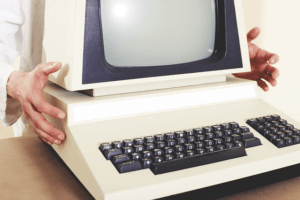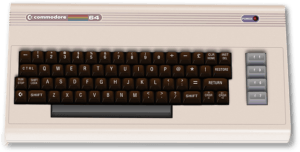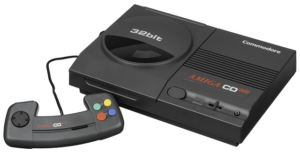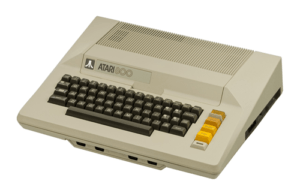Retrotech Laptops
The 1980s was when computing really took off. Sure, ‘mobile’ phones were the size of house bricks and ‘laptops’ were better placed on a table than your lap, but computing and technology were at least attempting to go mobile. Faxes were the way to go, although by the end of the 80s, what became the internet was in its infancy.
 Image by andreas160578 from Pixabay
Image by andreas160578 from PixabayBut apart from the electronic music of the era, most people will remember the 80s for the advent of home computing. At one end of the Spectrum (sorry) was Sir Clive Sinclair’s rubber-keyed bit of genius kit, released in 1982. The ZX Spectrum introduced many teens to gaming, with iconic games such as Manic Miner and Jet Set Willy. The Commodore PET was already illuminating offices with a strange green glow, and at the other end of the gaming rainbow, early Ataris (the Atari 400 and Atari 800) were available for those who could afford them.
But none of these iconic names invented the laptop, or portable computer. That honor went to Osborne. In 1981, a former journalist called Adam Osborne debuted the world’s first portable computer, the Osborne 1. It had a 5 inch CRT monitor and a load of bundled software. Despite this innovation his company, Osborne Computer, collapsed within three years. The machine was about the size of a sewing machine. It also weighed over 24lb, or almost 11kg, so a gym subscription might have been an idea for anyone owning one, as lugging it around would have been tiring, to say the least. It didn’t even have a battery, but it fitted in a case and could (just about) be carried.
Not to be left behind, Commodore released the luggable version of their incredibly popular Commodore 64, the first full-color portable machine. It was ‘only’ 9kg in weight, despite all the full color tech.
 Image by ralfsfotoseite from Pixabay
Image by ralfsfotoseite from PixabayAh yes, Commodore. The C64 was another one of the iconic 80s retro computing machines. To this day the rivalry between those who prefer Atari’s ST range and those who are die-hard Commodore C64 or Amiga fans is keenly felt. There are many clubs, societies and museums dedicated to the 80s gaming boom, when teenagers coded games to cassette tape in their bedrooms, copied the tapes and sold them illicitly to their friends. Magazines with page after page of code allowed keen players to transcribe games to their own machines, while instead of wanting to be train drivers or pilots, young boys dreamed of joining a big gaming studio and being paid to spend their days coding.
By the mid-80s, true laptops were on the rise and big names of the time such as Kaypro, Toshiba and IBM were quick to jump on the bandwagon. The Kaypro 2000, Toshiba T-series and the IBM PC Convertible were all introduced in the mid 80s. Machines had acquired a clamshell design, thanks to Grid Compass, and battery power after the efforts of the Kookaburra’s designers. They were also becoming lighter, with some of the more advanced models weighing under 5kg.
 Image by You're welcome! Thanks for your votes and comments! :) from Pixabay
Image by You're welcome! Thanks for your votes and comments! :) from PixabayAs the 80s progressed, so did the technology. By the end of the 80s, portable computers, still ‘luggable’ rather than truly portable, were being regularly released. The US Air Force was behind the development of the SupersPort series from ZDS or Zenith Data Systems in 1987, while Hewlett-Packard, Cambridge and Compaq produced ‘laptops’. The Cambridge Z88 was only about the size of a sheet of A4 paper, and is often considered the first personal digital assistant or PDA.
The last major release before the Age of Apple vs Windows was the NEC Ultralite, which was similar to today’s notebook computers. It had a 2MB RAM drive which meant it was smaller and lighter than ever before.
For many though, the Sinclair ZX Spectrum, or ‘Speccy’, was the first computer they ever owned, and life was never the same again. In the UK, without the likes of the Spectrum for games and the BBC Micro for words, many people would never have discovered their inner geek. Businesses started to have computers for their staff, and by the early 90s, huge (and noisy) dot matrix printers printing onto green and white striped computer paper were widely seen. Unlike the gaming machines, which used tapes, and the BBC Micro, which used rigid 3 1/2 inch diskettes to save data, these enormous machines had equally large 8 inch or 5 1/4 inch floppy disks for their memory.
 Image by WikimediaImages from Pixabay
Image by WikimediaImages from PixabayAt around the same time, Atari released a slew of machines in the US. The portable (although heavy at almost 7kg) Atari STacy from 1989 was essentially a portable version of the Atari ST with a screen attached. It was originally designed to run on flashlight batteries, but this proved a very expensive option and later models had the battery case glued shut, forcing owners to use mains power only. For those using it for music-sequencer work, this was not a problem. It may have looked like a chunky laptop, but it didn’t need to behave like one.
Another Atari model from 1989 was the Atari Portfolio. An early version of what is now called a palmtop, this machine was a licenced version of the DIP Pocket PC. It was essentially an electronic filofax, containing a text editor, spreadsheet, phone book and time manager.
Looking at these early laptops, palmtops, tablets and netbooks, it is not difficult to trace a direct path to the smartphones of the 21st century. The wish to cram more ability into less space has always been the driving factor, and as weights and sizes have dropped, computing capacity has risen. But without those early bedroom coders, many of today’s gadgets may never have been developed.
Is your laptop broken or too old and not keeping up with new software demands? You can sell used laptop to SellBroke for cash and upgrade to a newer one.
Retro Computing Modernized

For many people, the golden age of computing was the 1980s, when computers became affordable to all.
The big name models such as the Spectrum, the Atari ranges, the BBC, the Amigas are all several decades old now. But they are still functioning, still loved, and being adapted for today’s market in any number of ways.
Gaming expos
Gaming expos are big news in the UK. Play Expo, now run in association with Collectormania, can pack out Manchester Central (the former G-Mex) for a weekend of gaming, cosplay and talks. In addition there are traders selling refurbished machines, parts and games as well as retro game themed clothing, jewellery and household items. Revival, in Walsall FC’s stadium, is a similar event offering arcade games, retro computers, gaming tournaments and seminars. The added advantage is that the nearest hotel is quite literally at the other end of the stadium from the conference rooms, making it a very easy expo to attend.
For many gamers, expos offer a chance to see, and even to meet, some of the big names of their youth. Regulars at these events include the likes of Archer Maclean (creator of Dropzone and International Karate), Jim Bagley (more of him later), The Oliver twins (Dizzy) and David J Pleasance, formerly of Commodore. Matthew Smith (Jet Set Willy, Manic Miner) was recently warmly welcomed to PlayExpo in Manchester; his first live event for some time. The development team behind From Bedrooms to Billions are now onto their third film, and use the expos as a way to raise awareness of their work.
Demoparties
The European retro computing scene, meanwhile, specialises in what are called ‘demoparties’. The ‘demoscene’ is wide and deep, encompassing many countries where groups of like-minded geeks gather together to code programs for these 40-year-old machines which push them into places their designers never really imagined. At least once a month there is a multinational gathering of demosceners in a hall somewhere to host ‘compos’ judging the best program in many different categories. Compos are often limited by file size, machine and length, while the ‘Wild’ demo allows creative use of such things as oscilloscopes and LED light panels, as long as they are controlled by coding run through a retro machine.
Museums
For those who can’t make a gaming expo or a demoparty, there are always museums. Retro computing museums are springing up all over the place. The first well known example in England was probably The National Museum of Computing (TNMOC) at Bletchley Park, but many more have established themselves since, including The Centre for Computing History in Cambridge, the Retro Computer Museum in Leicester and the National Videogame Museum in Sheffield.
Modern tweaks
To keep these lovely old machines running and playable, modern technology has come to the rescue. It is not uncommon to see BBC Micros retro fitted with USB ports, for instance. The original floppy disks the machines relied on for saving data are becoming rarer and more unreliable, so a USB is the smart way to run programs and save work these days.
Likewise, demosceners such as Lotharek in Poland are using their skills to provide HXC emulators for many different types of retro computers. This allows otherwise fully functional vintage computers to continue to perform as expected, bringing pleasure to new generations of fans.
New machines
There have been several attempts to reboot old names using emulators or porting original games to modern day kit. The Amiga C-One, the Spectrum Vega and the Spectrum Next have all appeared since 2000, to be met with varying degrees of success. Current visitors to retro gaming expos are likely to see Jim Bagley and various others associated with the Spectrum Next, which is currently in prototype, funded by an ongoing Kickstarter campaign.
Games music
Meantime, retro games music composers are enjoying a renaissance. The new classical music station Scala Radio has a mixed playlist of classical pieces, film scores and gaming tunes. There is also an hour-long show on Saturdays specifically dedicated to video game music, but video game fans are just as likely to hear a recognisable tune at any time throughout the day.
In addition, live performances of retro games music scores have become popular. The Skywalker Symphony Orchestra might, arguably, have one of the best jobs in the world, playing music from the Star Wars movies, but for musically gifted geeks, playing at a retro gaming music event can’t be far behind in terms of job satisfaction. Concerts in Poland, Germany and the UK have been taking place since at least 2000. Composers such as Rob Hubbard, Martin Galway and Ben Dalglish are celebrated at these events for their contribution to the whole retro game experience.
These retro computers aren’t ready to go away just yet. Many original 80s bedroom coders have in turn introduced their children to the machines they loved as youngsters. Given that the computers are still working and available to play on in many museums and at expos, there’s still plenty of life left in them.